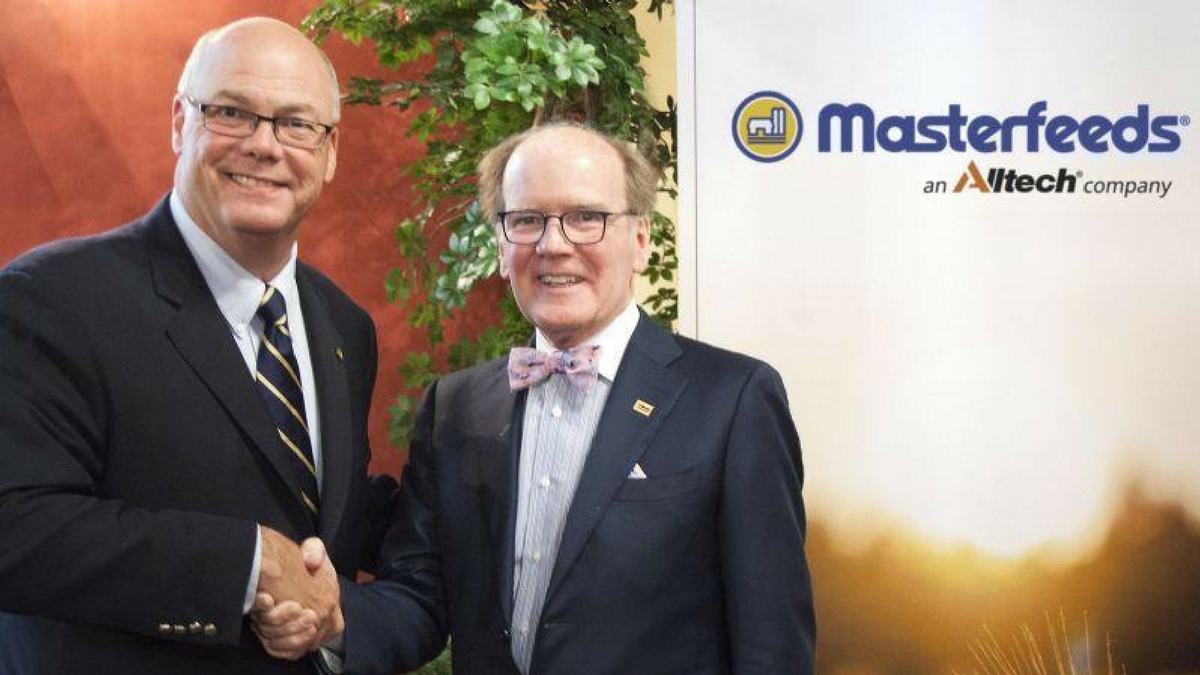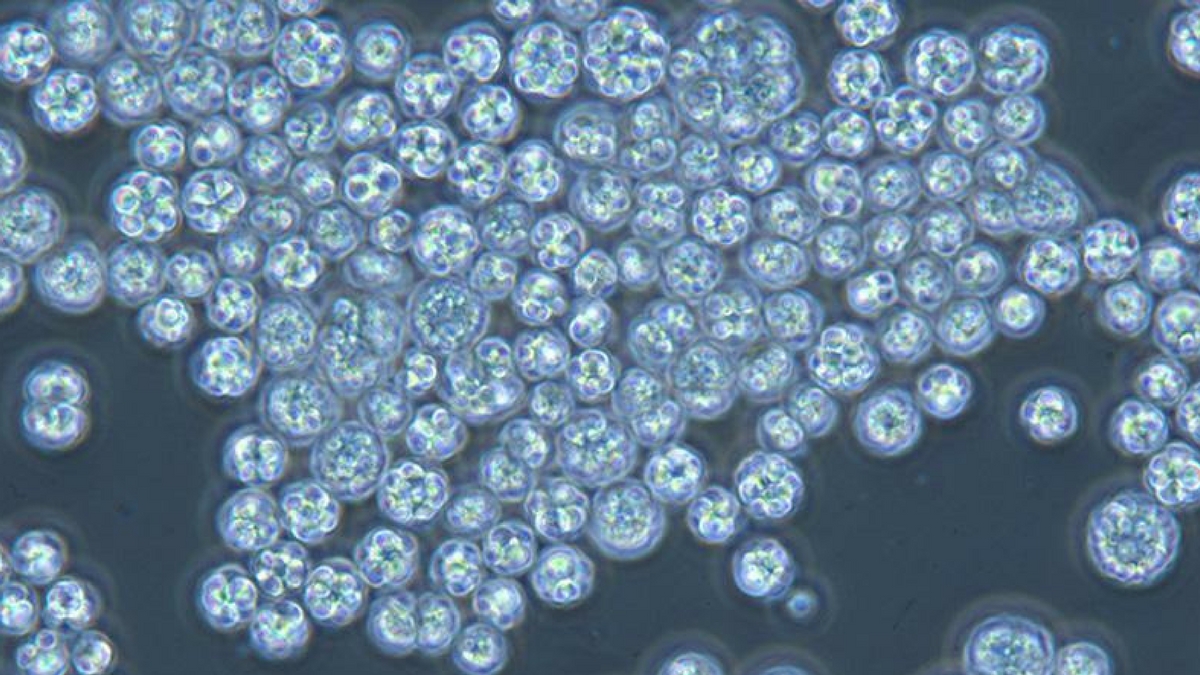In advance of the closing of Alltech’s acquisition of Canadian feed company Masterfeeds, we sat down with our president Dr. Pearse Lyons and the CEO of Masterfeeds, Rob Flack, for an unscripted, behind-the-scenes Q/A. The following is a transcript of the podcast.
Alltech and Masterfeeds have been partners for many years, can you tell us when and how this relationship started?
LYONS
Well, you know Canada has always been one of Alltech’s great marketplaces. When I first came to the United States, it was to Canada that I came first, and I will always remember going to Canada in February, which is not a good idea for some of you setting foot in North America for the first time. I began to understand why people get into their house as fast as they could. So, almost hibernate for the winter. But, as I traveled across the west, a real warmth towards Alltech, or what was the beginning of Alltech, so, somehow it was almost like a déjà vu. We go back to the ‘80s, we go back to meeting at different feed meetings like the Guelph Nutrition Conference, like the nutrition conferences, which were held out in places like Calgary and even indeed up into Montreal. This is a relationship that goes deep, a long, long relationship.
FLACK
Well, I guess it would be that I met Dr. Lyons years ago. And, Pearse, if you don’t mind I’ll tell the story about when I came down to the Kentucky for the Kentucky Derby with Alltech and at the time I believe your right hand man, Dr. Lyons, Bill Cheek.
LYONS
Yes, good ol’ Bill Cheek, I have his picture right here on my desk.
FLACK
And, we had our dinner with a group setting, with people from all over the world. And, when the dinner was done, we had a sing-song and a laugh and some good cheer and pictures were being taken, and a picture was taken with me, I assumed, of me and my wife Denise, and some others, and I got home and as I was sitting at my desk, a letter came in from Bill Cheek who had wrote a nice note thanking us for coming down to the Kentucky Derby: We enjoyed hosting you and lovely picture of you here with your bride-to-be Denise. I looked at the picture and lo and behold it wasn’t my bride-to-be at all. It was another woman altogether, and so I wrote him a beautiful tongue-in-cheek response saying, I’m in deep trouble, this is not my wife at all and she’s read this and seen this and I am in deep trouble. And, he took it seriously, unfortunately, but sent me the most beautiful picture of a Kentucky morning turnout and, I believe, your wife, Mrs. Lyons, had this framed. To this day, we have this hanging in our house so we can’t not think of Alltech when we look at this picture.
So, it was some fun beginnings and that was close to 25 years ago. And, the other big experience was partnering with Alltech in the 2010 Alltech FEI World Equestrian Games in Kentucky, and we had some fun for sure doing this.
What makes this acquisition a positive move for both companies?
LYONS
Well, you know, it’s not an acquisition, it’s a coming together of like-minded people. It’s not an acquisition, it’s a coming together of friends. I will quote what one of our people said this morning; they said “so far this is one of the easiest mergers coming together that we have had” and we have done, like, 10 of these so far. This one was just dead easy. And, what makes it positive for both companies is the synergies that can occur. What makes it positive for both companies is that we can bring to the farmer, the Canadian farmer, the technology that we have and what Masterfeeds can bring to us is their technologies. And, since we are a company in 128 countries, and Canadians are great, great travelers and are very well-accepted across the world, we see the nutrition that Canada has as being of great use to people in China, to people in South America. It’s not 1 + 1 = 2. It’s 1 + 1 = 3 or even 4.
FLACK
And to add to that, the word I would use, is what we are seeing and why it’s so positive, is that we are seeing a lot of cross-pollination between all the Alltech divisions, whether it’s shared technology, their experiences across the world. And, I can say that I’ve done a lot of deals, and this has been the most exciting deal and change that I have seen internally in our 86-year history, not that I have been around for 86 years, but for the last 35 years plus, and this is absolutely one of the most exciting ownership changes we have ever been through.
LYONS
And, I will add to that. It’s not just an ownership change. They are joining a family business; they are joining a business that is not for sale, namely Alltech. They are joining a business that will not go public. So, it’s a win-win. It’s a win for the people out there, the Masterfeeds people. It’s a win for the Alltech people and when you know you’re not for sale, and when you know you’re not going to be flipped, and so forth, then it just makes for a very comfortable situation. I am surprised that we didn’t do it before.
Well, now that the deal has closed and we begin the integration process, what opportunities do you expect to see emerge?
LYONS
Well, I can only tell you what has happened in some of the other deals that we have done. First of all, we expect to see a nice improvement in the profitability of Masterfeeds, Masterfeeds themselves. We expect to see some of that coming from synergy, we expect to see some of that coming from things they learn from us and vice versa, so there will be an improvement in profitability. Then equally the ability for us to get our technology out to the farmer through Masterfeeds. We are so excited. The guys came into me this morning and they said, some of our people said, wow, we have just been into the analytical services laboratory that they have up there and they do so many hundreds of samples and so on. This was our crop science people. Oh, and we believe we can bring more samples, and we believe we can do this and we believe we can do that, and so on. You know the benefits for us, the benefits for the Canadian farmer, and the benefits for the U.S. farmer, I don’t think we really realize just how great they’re going to be.
FLACK
What amazed me since we started our discussions really, Dr. Lyons, back in April, and as I obviously become more involved inside your company is the diversity and so much of that diversity can be incorporated within both our products and programs and it’s not only products and programs, but it’s the cultural diversity, the enthusiasm, the big picture thinking that truly is infectious, whether it’s animal nutrition innovation, that’s a given. I think that synergy is going to complement both of us. Crop science applications as you just mentioned. We are growing significantly in that area in terms of sampling and soil application working with crop science companies. New algae products. Everyone who has been down and toured that algae facility, including me, the new products on the horizon are simply, it’s just exciting, and blows your mind in terms of the applications going forward, all of these represent new opportunities for Masterfeeds and quite frankly new opportunities for our customers, and we’re excited about taking them to the farm gate.
So, we touched a little bit on the benefits that Canadian farmers and ranchers will see, can we get a little more specific on that?
LYONS
Yes, you know, to me, farmers, I don’t care whether they be Hutterite farmers or whether they be corn growers, or whether they be pig farmers, farmers are born entrepreneurs. Farmers always ask you one question—what’s new, what’s new, what’s new—and that’s what they want to do. They want to try things, and I think what’s going to happen now with the Canadian farmers in particular, since that is where we are, right above Canada now. They are going to get the benefits of our experience from 128 countries. We are going to hopefully bring, some of them, to 128 countries. And, if there is an opportunity in Manitoba or an opportunity in Ontario, or if there is a challenge in Manitoba or a challenge in Ontario, we can immediately go to his friends, and Alltech is a company of friends, and he can go to his friends in 128 countries and say this is what we’ve got. Could it benefit you? Or, this is what we’ve got, do you have anything that could benefit us? It’s all about communication. It’s about two or three things:
- We have to have size. You can’t be too big, but you have to have size. With Masterfeeds, we have size.
- The second thing is you have to have innovation. I am in love with innovation. I love the challenges, I love to be able to go into our laboratories and challenge the guys to do this, this and this, and that’s the innovation part.
- Speed - You know, Rob, when they place an order, they don’t expect the order to come in three weeks, they expect the order to come in three hours. So speed, speed, speed.
- So with Masterfeeds we have size.
- Do you realize we are the number one feed company now in Canada?
- Do you realize that we are the number three feed company in North America?
- Do you realize we are feeding 35 percent of the layers of North America?
This is huge and this means that we can bring that technology and respond fast. So, size, innovation and speed. And, let’s face it, Canada is only beaten by the Canadians who live in Canada.
FLACK
Two things come to my mind, David, and Dr. Lyons has touched on them. The product technology will benefit, obviously, our customers, and that technology is designed to promote sustainable, safe, environmentally-friendly and, importantly, profitable meat, milk and egg production in Canada, and that’s what we do every day at Masterfeeds. But this complementary relationship with Alltech is going to enhance that ability and give us more arrows to offer direct to the farm gate.
But let me add on to the innovation and technology, what again, I experienced first-hand, a couple of things that just really excited me and I know excites our people, our sales, marketing and nutrition folks in the field, is that Alltech is exploring the benefits of utilizing nutrigenomics to develop advanced feeding programs that will benefit our customers. It’s new and cutting-edge technology that will eventually come to the fore as well as the application, and this is really big right now—growing technology in Canada, antibiotic-free animal nutrition solutions.
Those are two things that are at the doorstep of benefits and products and technologies that we are going to be able to incorporate and take to the field, and our people are literally chomping at the bit to try and get at it and take that special advantage that they will have at the farm gate and help our customers become more profitable and more sustainable. It’s right there.
It sounds great. When a local company is purchased by a global company, sometimes customers might have concerns that their experience will change. So, Rob do you have a message for customers and what they might be thinking about right now?
FLACK
Well, a couple of things I would say. First of all, I will add to the term local. Local in terms of country. We are in five provinces. We are going to have 25 feed plants when we’re done; we’re going to have close to 700 employees. We have some scale. I think it’s important to note, and I think Dr. Lyons will agree, that once we conclude here, we’re going to integrate and realign synergies and we’re going to do our best to maximize profitability and performance. It is business as usual. So our customers will have the same sales rep, the same nutrition packages, the same service, the same transportation support. It is business as usual.
You know change in life for most people creates uncertainty. And, that’s normal human response. What I have been telling people consistently is that I also believe change can be very positive, and I always embrace it. I like it. It’s kind of part of my DNA, but I try to make that again infectious with everybody that this change with Alltech, albeit a change, and with what Dr. Lyons talked about this earlier, it’s not really change in a major way, it’s a change in a positive and good way, and in this case, Masterfeeds is becoming part of the Alltech family and, in fact, Alltech becoming part of the Masterfeeds family is fantastic and I can’t wait for this positive outcome to play itself out in the marketplace.
Dr. Lyons, will this acquisition have any impact on Alltech’s global operation?
LYONS
Well, first of all, the amazing thing is that when I listen to Rob and I listen to also his people, the words and the things that they are saying and the feelings that they are expressing are spot-on with what makes the Alltech culture.
Culture is what makes a business different, and if ever there was an acquisition or merger or a coming together of cultures, which fundamentally are not very different, it is Masterfeeds and Alltech.
The other thing to remember is that Alltech doesn’t consider itself to be a global company. We consider ourselves to be a local company. Yes, we operate globally in 128 countries, and we have the advantage of that, but we think very much locally. When we work in places like Brazil, we work through the local language. When we work in Ireland, we work through their local cultures, and we don’t trying to foist upon Canadians a German culture or a French culture. We work locally and I don’t think that the local farmers and the local customers and indeed our friends at Masterfeeds are going to see one thing change, not one thing, because they already have changed. Because they are so close to us, change isn’t necessary.
Having said that, what impact could it have on our global business?
I was in Latin America earlier in the week and was thinking as I was looking around, “Wow, you know there is a pig starter, there’s a pig creep that in fact I know is made by Masterfeeds that I know would work and work very well down here.”
When I saw some of the stores that some of customers that we were visiting, I said I know those stores that Masterfeeds have that would work and work very well. We had to be a little careful of what we said and to whom we said it, but each and every place we went to, “Wow, you’re working with Masterfeeds has been announced. We want to know more about Masterfeeds and oh, by the way, is it a possibility that we could be your Masterfeeds here in Italy, here in Mexico, here in Russia.” It’s just an extension of all of the fun we have had throughout the years.
Alright, that is very exciting. Do either of you have any closing comments?
FLACK
I will maybe start off and let Dr. Lyons conclude. Obviously a lot of work has gone into putting this deal together. There has been a lot of dialogue, a lot of sharing of information, and a lot of communication and again, to reiterate what I said earlier, what has made me so enthused throughout the process has been the open, positive and collaborative work that has taken place thus far, and I know will continue to take place and the adjective that I would use is contagious. What I’m finding with our people is more people go down to Lexington and Alltech folks come up to London to our headquarters, I’m finding there is a contagious enthusiasm that is taking place. Again, I’ve done many deals throughout my career, but this has been the most contagious enthusiasm I have experienced of any one we have ever done. We have 86 years, Dr. Lyons, that we have been around, and we look forward to the next 86 years. You and I probably won’t be around to celebrate, but you never know, through nutrigenomics we may just get there. We may just get there.
LYONS
All I can say, is this is easy. This is just two like-minded groups coming together and those guys are so excited up there, and we’re so excited down here. Roll on; let’s get it done.
























